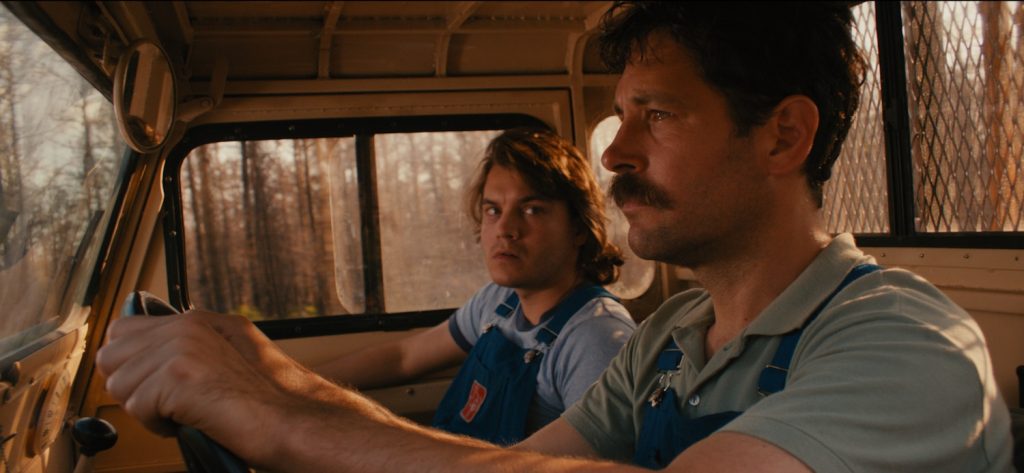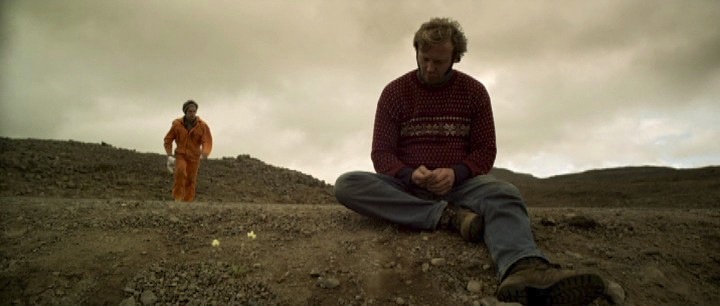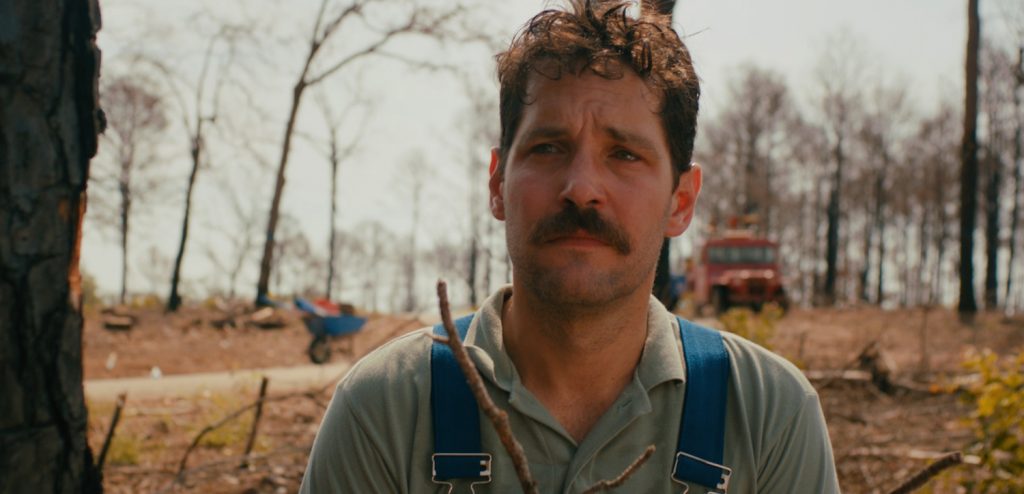David Gordon Green rose to prominence as a kind of folk poet of southern regional cinema, creating unconventional but compassionate portraits of young folk in rural cultures in the films George Washington, All the Real Girls and Undertow. With Pineapple Express, a stoner buddy comedy with James Franco and Seth Rogen, he began a three-year sojourn in Hollywood comedies that produced Your Highness and The Sitter and the HBO comedy series Eastbound and Down with Danny McBride.
Prince Avalanche, a modest, warm-hearted tale of two guys on a rural road crew on winding forest roads in 1988 Central Texas, gets Green back to the basics. The film has the quality of an American short story, easy-going, laconic, seeped in rural atmosphere, analog technology, and a slower way of life than the movies rushing through the multiplexes. So it’s somewhat surprising to discover that it’s actually a remake of an Icelandic film called Either Way, completely recast by the southwestern setting and the sensibilities of Green and his two stars, Paul Rudd and Emile Hirsch.
I talked with Green in May 2013 at the Seattle International Film Festival, the afternoon before he debuted the film for Seattle audiences. After a few years of Hollywood comedies with big advertising budgets, he was back in the indie world where word of mouth builds interest. It’s a world in which he’s right at home. “Man, I could do that all day,” he remarked as we shifted from chatting about some of the recent films he’s seen to talk about Prince Avalanche. “I’m better at talking about other people’s movies.” He was being modest. Prince Avalanche was clearly a labor of love and that love came out in our interview.
Keyframe: How did you first see the film Either Way and what about it made you think that you wanted to remake it as an American film?
David Gordon Green: I wanted to remake it before I saw it. Someone who hadn’t seen it was telling me about the idea of it and I said, ‘I want to remake that.’ So I watched it for the first time thinking about how I would remake it. So I’ve never seen it honestly. I’ve only seen it under the guise of what I would do to it so it’s not really fair to those guys. I love their movie, I think it’s amazing and it’s beautifully shot. Have you seen it?
Keyframe: I’ve seen your film but I have not seen Either Way.
Green: You should see Either Way, it’s masterfully done, very beautiful, almost all done in master shots, very little coverage in the movie. It’s really a warm-hearted, charming movie, very much the inspiration for where we went with Prince Avalanche. I think Avalanche is a little bit more absurdist an a little bit more emotional, but this movie really struck me for the simplicity and beauty of it and kind of a Waiting for Godot quality, the lost existence of man and men struggling with identity and masculinity. I really loved the architecture of that film and felt a lot of opportunity to bring my own relationships and my own ideas, my own internal dialogue, my own internal conflicts, relationships with women, relationships with myself, relationships with nature and incorporate that all into the framework of Either Way.
Keyframe: It’s interesting to see a film about two men and their relationships with people that we never see them in relationships with. They are always apart from the people that they are talking about and thinking about.
Green: I would like to make a companion film to this movie, to see things that aren’t exposed in this movie. I’d like to know these women a little bit better, I’d like to see the weekends that Emile Hirsch has on his own. I have a lot of curiosities and uncertainties about this movie, but I think that’s one of the things that I’m most fascinated by. I don’t have an answer for everything, it’s very much an exploration. There’s a woman that they meet along the way that was not in the script, it was a woman we met in a home that was hers, and we just incorporated her truthful story and environment into our movie. So the movie really had that kind of life where I don’t really know what she represents in the movie. It’s almost like a supernatural character, kind of a ghostly character that they encounter. I never really set out to make a movie like that, it just became a movie like that. There was a beautiful sense of discovery throughout the production.
Keyframe: Was that first scene with her at her actual home?
Green: Yeah, that was her home. There’s the scene where Paul Rudd is pantomiming and we were looking for that house and then we found this lady in this other house and she was just kind of walking us through her house and then rather than just asking for the use of her location, we said, ‘Do you mind being in the movie?’ She was just this magical woman looking for her pilot’s license. I loved it.
Keyframe: There’s a kind of ghost story quality to that scene, where she talks of everything in past tense.
Green: Yeah. Every time I see it I feel something different and I think that’s the sign of a movie that I’m really proud of. It’s not the perfection of what I did but the fragmented threads and tangents of what I did, and the fact that I still wonder about the movie rather than have this utter confident and certainty about it. My confidence is in that I think it’s something that I think audiences will enjoy, but I think they’re also going to find the same curiosities and discoveries that I have.
Keyframe: I was surprised to see that a year after a forest fire, the forest didn’t look devastated. The house is dead and burned down but everything around it is green and roaring back to life.
Green: And that was the urgency of making the movie. There was this rebirth happening, with these beautiful little oak trees and pine seedlings, all a foot or two tall, but above them are seventy feet of chard black toothpicks. So there’s a very haunted quality to that and obviously a devastated dramatic quality to that, but I was really drawn to the beauty of the rebirth. There was this vibrant green of vegetation underneath the blackness of these burnt trees and then the blue of the sky and the yellow of the lines on the road, there was just such a strange color palette there that I knew I had to film something there.
Keyframe: Why did you set it back in 1988?
Green: The original film was set in that time period and I considered trying to update it. But then I found all the devices of communication and connection to people such an obstacle, where I thought, ‘Well, all I have to do is set it before there was cell phones and then all of a sudden they are more isolated.’ You can’t detach from someone you’re working with like you can now. If you’re stuck on the road in a job with a person you’re butting heads with, it’s going to really get under your skin, whereas now there’s a million ways to detach from them. Certainly the machinery and equipment that you’d use would probably put you in a truck and robots would be doing the work, but you’d be Skyping your girlfriend or your wife at the end of the night and you’d be talking on the cell phone during the day. I liked the idea that these guys had a more primitive connection to their environment and more primitive connection to each other.
Keyframe: I get caught up in the texture of the worlds on screen. 1988 is twenty-five years ago, and I was reminded at just how much camping equipment has transformed between then and now. It is a different experience.
Green: A lot of that was my own camping equipment from childhood. Now it’s all high tech. I went to Cabella’s the other day and realized that there was so much gear you can have nowadays where, for me, it’s just an old Coleman stove and a crappy canvas tent and a rectangular sleeping bag, whereas now it’s made with all sort of microfibers.
Keyframe: And you can carry it all on your back without straining yourself.
Green: Even backpacks now. They used to weigh sixty-five pounds and now they are lightweight. It’s amazing.
Keyframe: In the film’s drinking scene, where Paul Rudd is trying to get over his girlfriend, for a guy who is out there, communing with nature and ostensibly at peace with himself, he’s got a lot of hostility in him.
Green: Oh yeah. The beauty of working with an actor like Paul Rudd is that he’s got a very likable quality, I kind of liken him to a Jack Lemmon. People know him from mostly comedic work, but to be able to explore the darker stuff, the more emotional side, the anger and the frustration within him, was such a beautiful part of that relationship, and Paul was, I think, very hungry to go there. He knows he can get into funny mode pretty quick but to be able to play the dramatic angles of this character was really important to both of us.
Keyframe: Had you worked with Paul Rudd or Emile Hirsch before?
Green: I hadn’t. I met Paul in Amsterdam in 1999 and we’ve been friends ever since. Emile and I were supposed to make a movie together several years ago which fell apart and we kept in touch since then. He went on to make Into the Wild and Speed Racer and some really big movies and I’d gone on a kind of big comedic tour of doing other kinds of projects and it was kind of fun to be able to look at each other and say, ‘This is time to be honest with ourselves about what we want to do.’
Keyframe: You cast Seattle filmmaker and actress Lynn Shelton as the (unseen) voice of Paul Rudd’s girlfriend. How did you cast her?
Green: I was calling her for some advice on how to deal with SAG contracts on the movie. I’ve known her for a while and she’s someone I look to or she looks to me for advice on actors or things like that; so we use each other as reference points from time to time. And I was calling her about something fairly mundane and I was listening to her talk and I was like, ‘And… would you play the part of Paul’s girlfriend?’ It was just like, literally, talking on the phone gave me that idea and then she said, ‘Sure.’ She’s starting a new movie on Monday, I think (ed. note: Laggies, which Shelton shot in Seattle in June and July). I haven’t seen her latest one but I really like Your Sister’s Sister.
Keyframe: The last three films you made were bigger, more mainstream Hollywood comedies. Coming back to a small, character-focused, small-cast movie like this, how has that sojourn changed the way you make films, or has it?
Green: Every film changes the way I make a film. Every project leads to the next. Let’s see, my first film came out in 2000 so it’s thirteen years of working, and everything informs the next one. I wake up every day with a new sense of opportunity. It’s very interesting to go from films where you can take as many takes as you want and you have very reasonable schedules of your days and everyone is getting paid and all of a sudden you take those three elements away. We could get two or three takes at the most, we had a sixteen-day shoot as opposed to the movie before where I had a fifty-day shoot, so sixteen days to make a movie is not that much, and you have to rely on a small crew that’s not getting paid much money to be there. And you’re filming in the middle of nowhere and you’re staying in a motel that isn’t by any means luxury. So it was fun to be able to strip it all down and I talked specifically with my cinematographer, my production designer, and Paul and Emile, about what do we love about the moviemaking process, what is the stuff that keeps up passionate and keeps us loving our job and wanting to keep doing it. So we made lists of things that we loved. Okay, so now what do we hate about it. We hate all the expectations, we hate all the baggage and all the people asking questions and ‘Why are you doing this?’ and ‘What if that’s not funny?’ and all the development of making a movie. What we like is the momentum of making movies, we like the momentum of filming things and trusting each other and challenging each other. So we really stripped it all down to being that and this is a movie of trust and challenge. You’re in a very uncomfortable, burnt-down, ashy place, it didn’t smell nice and there was no real way to clean up between the days. It was a very unluxurious, unglamorous production. But the beauty of it is no one even knew we were making the film. We made it very quietly and incredibly cheaply so that no one asked us why we were doing what we were doing or even what we were doing. It’s kind of refreshing to not have any expectations or any demands.
Keyframe: So if you had only a little bit of time and only a few takes, did you have a long rehearsal process? Did you shoot it in chronological order?
Green: As much as we could we shot it in chronological order but we read through it once. That was our rehearsal. We jumped right in. We were looking for momentum and not perfection. We wanted it to have this kind of organic life, there was nothing calculated we were looking to achieve. Much of the script is not in the movie and much of the movie is not in the script.
Keyframe: So there’s a journey of discovery along the way. As you are making the film, you are also discovering it.
Green: Yeah. Emile was curious when he signed on to the movie, he asked, ‘Who is this movie for?’ And I told him, ‘This movie is for us.’ He was curious about the audience and the demographic we were trying to hit and it was like, ‘No, this is like for our twenty friends.’










